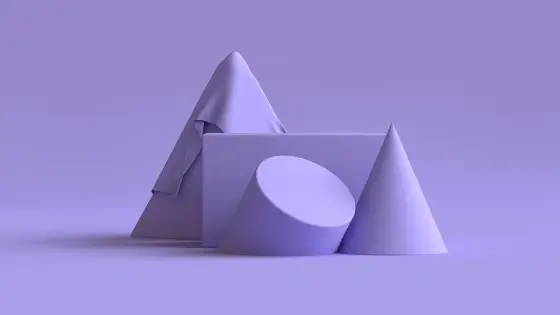I was looking for specific songs with ABA form to use in my classroom, and there were tons in AB form, but little in ternary. So I did some research and came up with these 6 engaging options.
Songs with ABA form, also called ternary form, consists of two different sections where the first, familiar section returns at the end. This form is very common in many children’s songs. Here are some examples:
- Grandma Grunts
- Tingalayo
- Twinkle Twinkle Little Star
- Button You Must Wander
- Old King Cole
- Down To The Baker’s Shop
Check out the rest of the article for notation, game directions, and sample activities for how to help teach form.

Save time with these 60 FREE Music Resources to use in your room right away!
Stop searching the whole internet to find good activities. I’ll help you cut to the chase with my favorite 60 FREE resources.
Table of Contents
What Is ABA Form In Music?
In music, songs and pieces can be divided into different sections called form. Larger sections are given capital letters starting with A.
When a new section is introduced, the next section gets a capital B. This continues as the music goes.
If material is reused, the section is given the same letter as the section it matches. For example, ABA form would have one section followed by a new section followed by another section reusing the first section’s material.
ABA is also called ternary form. While present in children’s songs, it’s also common in classical music, especially with the minuet.
Looking for other forms? Read more on songs with AB form.
This video has a kind of interesting take on ABA or ternary form.
6 Engaging Songs With ABA Form
In this section, you’ll find the notation and games for 6 of my personal favorite ABA songs. If the song and game come from a specific source, I’ll include a link to that site for you to check out the notation.
I’ll also briefly break down other teaching information about each song for you. Enjoy!
Psst. Get 155 more folk songs by getting the Sail Away folk song collection. It has so many great songs.
Click the link to check it out on Amazon. (Affiliate link and all that. Small commission for us; no extra cost for you; win-win!)
Grandma Grunts
This song works well with older kids. The song requires some whistling action and has quite a few words, but the melody is simple and catchy.
Grade: 3rd – 5th grades
Rhythm Concepts: sixteenth-dotted eighth, eighth-2 sixteenth, 4 sixteenth, paired eighth, quarter note
Melodic Concepts: do, re, mi, sol (wonderful for re)
Game:
Notation at the American Folk Song Collection.
Tingalayo
This Caribbean folk song is a fun one with many recordings by children’s artists such as Raffi. The story is funny, and the song is memorable.
Students can also easily create their own new lyrics about Tingalayo.
Grade: 3rd – 5th grades
Rhythm Concepts: sixteenth-eighth-sixteenth, sixteenth pickup, single eighth, half note, quarter rest, paired eighth
Melodic Concepts: do, re, mi, fa, sol, la, ti, do
Game: Movement game in single circle formation.
- First 8 beats, circle right*
- Next 8 beat circle left*
- Mime the words to the verse (students can create)
- Repeat
*On the words, “Come little donkey, come” you can have students do this movement for a challenge: stomp-clap-stomp-clap-clap-clap.
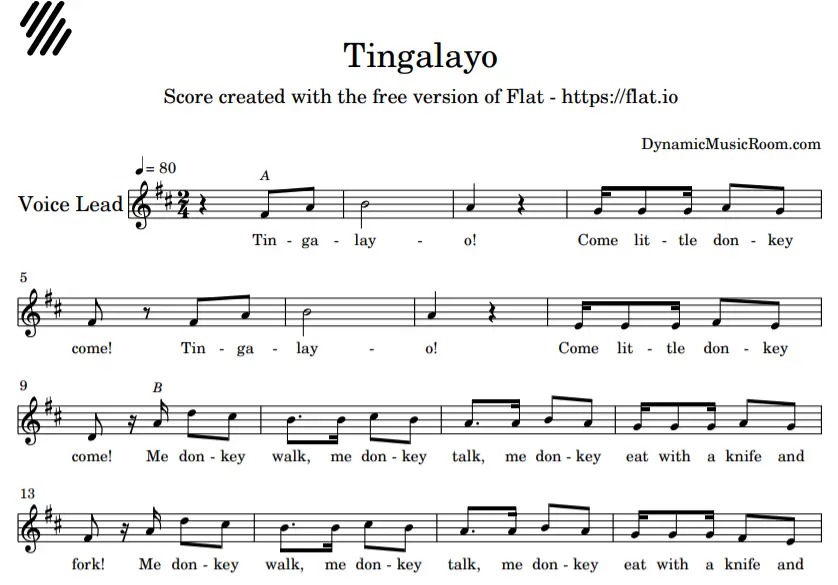
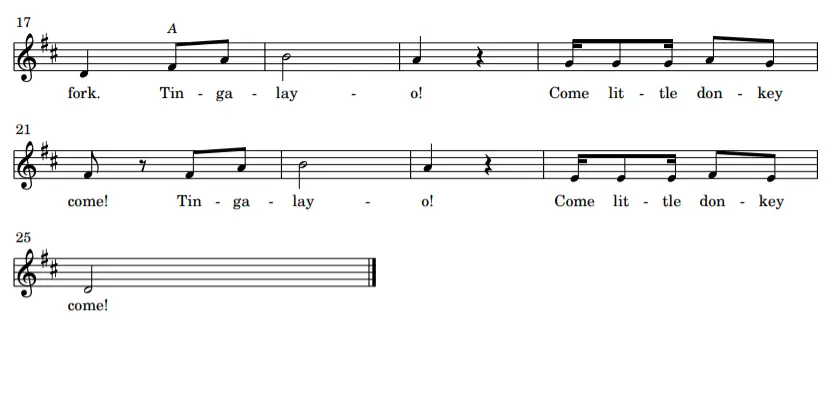
Other B section verses:
Me donkey fast, me donkey slow,
Me donkey come and me donkey go!
Me donkey hee, me donkey haw,
Me donkey sleep on a bed of straw!
Me donkey dance, me donkey sing,
Me donkey wearing a diamond ring!
Me donkey swim, me donkey ski,
Me donkey dressing so elegantly.
Bonus: I love prepping this song by having the younger kids sing along with this Raffi version of the book.
Twinkle Twinkle Little Star
It doesn’t much more simple yet effective than Twinkle Twinkle. Many young kids will already know this song allowing you to get right into the learning.
Grade: Kindergarten – First Grade
Rhythm Concepts: Quarter rest, quarter note
Melodic Concepts: do, re, mi, fa, sol, la
Game: There isn’t an established game for this song, but you can always have students create motions for the words or choose different ways to keep the beat.
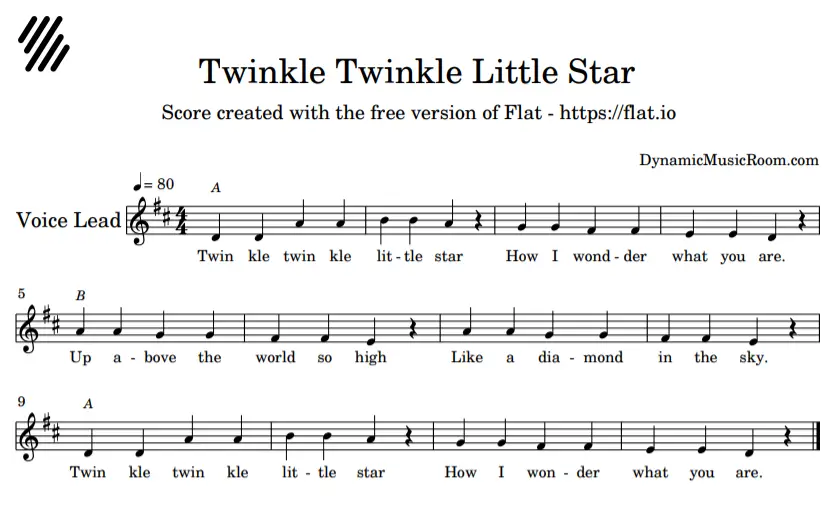
Button You Must Wander
With a simple melody and rhythm, this is perfect for reinforcing “simple” musical concepts with older beginners.
Grade: 3rd – 5th Grades
Rhythm Concepts: half note, paired eighth notes, quarter notes
Melodic Concepts: do, re, mi, sol, la
Game: I play this game as a hot and cold finding game. One student hides the “button,” and one student has his/her eyes closed.
The rest of the class sees where the button is hidden. Then, the finder begins to search.
As the finder searches, the class sings louder (without yelling) when he/she gets closer and quieter as they get farther.
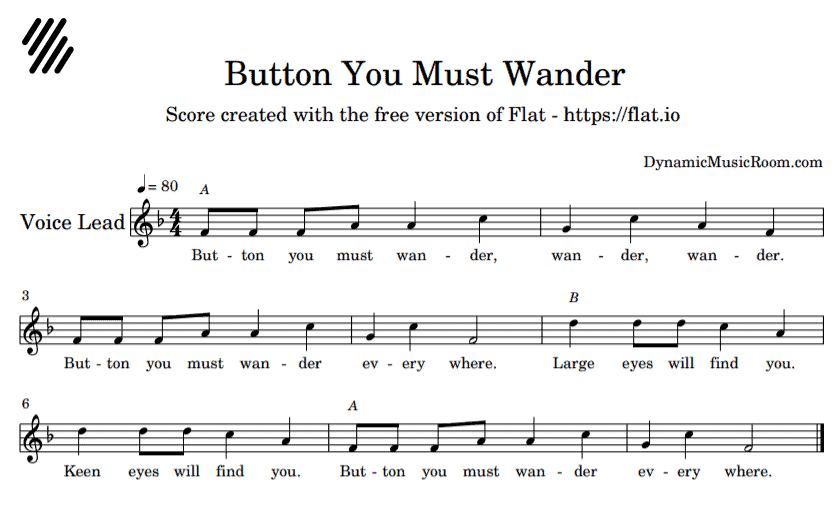
Old King Cole
The words and melody of this nursery rhyme are haunting and beautiful. This is a complex song but great for getting into form and minor.
*This song is a modified ABA. The first A doesn’t match the second exactly, but there is clear repetition of melodic material.
Grade: 3rd – 5th Grades
Rhythm Concepts: dotted half note, whole note, paired eighth, quarter note
Melodic Concepts: low mi, low si, la, ti, do, re, mi, fa
Game: No specific game, but the minor melody will keep your students more than entertained (especially if you throw in some piano or xylophone parts).
Notation at Beth’s Notes.
Down To The Baker’s Shop
This is a simple, but fun song. And there’s nothing wrong with that! My kids love playing this one.
Grade: Kindergarten – 2nd Grades
Rhythm Concepts: dotted eighth-sixteenth, quarter rest, paired eighth, quarter note
Melodic Concepts: do, re, mi, fa, sol, la
Game: Hop the first and third lines. Skip (or gallop) the second line.
Notation at the American Folk Song Collection.
2 Activities To Reinforce ABA Form
Form is one of the most fun things to teach. It lends itself so well to visual and kinesthetic learning.
Here are two of my favorite activities for teaching ABA form.
Battling Instruments – After students know the song well, invite them (or assign them) to one of two groups of instruments. I tend to use drums and tambourines.
Depending on their level, you can have these students keep a beat or perform a simple ostinato. Each instrument group is assigned a section of the form.
Perform with the song. Then switch!
Form Artists – I love doing this one because it always impresses me how much more talented in the visual arts my students are than me!
This one works well with my younger kids, but many of the older ones enjoy this as well. Ask your students to draw (I use notecards and crayons) three pictures, but two of them have to match.
These pictures match the ABA form of the songs you’re teaching (check out these additive form songs). As they perform the song, they have to hold up the correct section to show the form.
Then, try mixing up the form order just to see what happens. Kids like to experiment.
Conclusion
I hope you find this list of 6 engaging songs with ABA form helpful. Form is a great concept to teach because it connects very easily with popular and classical music of all kinds.

